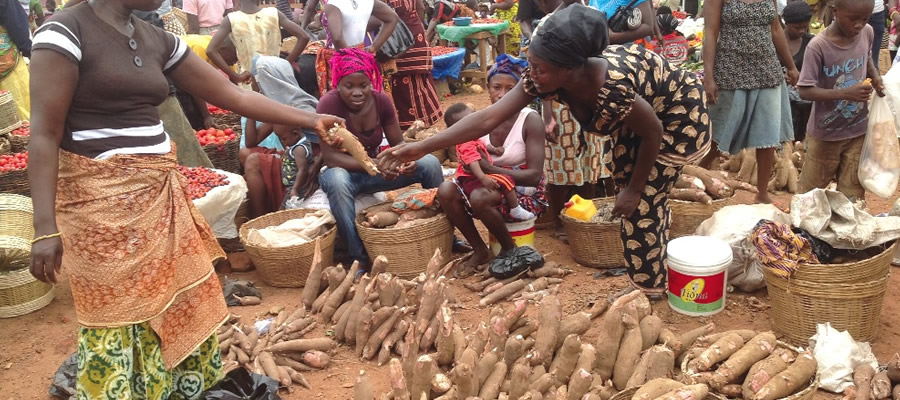

Culture
The people of the land are predominantly Krobos, who according to history acquired the land from the Akyems. However, there are Ewes, Akans, Hausas and other tribes as well. The widely spoken language in the district is Dangme
Historical Background of the Manya Krobo’s
It is open fact that the Krobo people originally migrated from what we know as Eastern Nigeria, many years ago. Initially they were based over the river called tordzen in Volta Region around the year 1500 AD, one of their hunters of great repute by name Nene Akro, recommended that the tribe move to Krobo mountain, and they did. If you fly around the mountain you will see that it is a natural fortress and provides great visibility over the savannah lands (much of which used to be flood plains prior to the construction of the Akosombo Dam). By 1760 the Tribe had 6 clans namely; Piengua, Jebiam, Suisi, Dormi, Akuenor and Manya. With colonisation the Krobos were under more and more pressure to resettle off the mountain.
It was not easy to rule over a Tribe that operated from such a fortress! Between 1835 and 1892 the Danish organised four unsuccessful expeditions against the Krobos with the aim of dislodging them. But it was in July 1892, during the mourning of the death of King Sackitey, that the British forces, based in Akuse (near Kpong Dam) laid siege to Krobo Mountian, and using heavy artillery finally negotiated a resettlement of the people along the Akwapim ranges (Somanya to Kpong) and the purchase of the mountain for £300. The mountain is still regularly visited by the Krobos each year at festival time (Ngmayem festival). The widely known Ngmayem festival is celebrated in last Friday of October each year.
They were ruled by priests who were neither allowed to have contact with strangers i.e. uncircumcised men or to be involved in warfare, nor were they allowed to leave the mountain and its nearest surrounding. As an integrating element of the Krobo society; the puberty rites for the young women "Dipo" and the worship of the wargods Nadu and Kotoklo were of great importance.
From the plantations the expansion went on westwards. Krobos purchased lands beyond the mountain range by using the Huza-system described by Margaret Field (The Agricultural System of the Manya-Krobo of the Gold Coast) in 1943, i.e. the purchasing of land by co-operative groups under the guidance of a "big man" who had enough importance and influence to deal successfully with the landowning Akans - or the Guan-(Kyerepong) and Akim-neighbours. It is easy to perceive that the needs of this society could no longer be exclusively met by the priestly oligarchy with its restrictions mentioned above. The big men that came up with the expansion had a certain authority as huzatse (master of the Huza) within the Huza-farming and with the economic growth expanded their positions rapidly - Krobo now increasingly cultivated food crops and sold cash crops such as maize and palm oil to their neighbours.
Cultural Practices:
The widely known Ngmayem festival is celebrated in last Friday of October each year. This lasts for a week and brings lots of people (citizens and non-citizens) to Odumase-Krobo, presenting an opportunity for development interventions. Several rites are also performed by the Krobos’. Notable among them are the Dipo, Lapomi and Kadoba Fiame.
Dipo is a puberty rite performed for young adolescent girls who are of “sexual age” or “manarchial age”. It is done to usher the girl into adulthood. In all intents and purposes, Dipo is a positive rite that initiates the young woman into knowing her responsibilities before stepping into marriagehood. This tradition dates centuries back and should be encouraged, but with modification.
Lapomi denies fathers of naming rights until some customary rites are performed. This practice appears to have promoted single parenthood and its accompanied constraints.
Kadoba Fiame (scarification) is mostly done by traditionalists, herbalists and spiritualists as part of treatment and healing. One knife is mostly used for such operations and thus risks the transmission of HIV to other clients which need to be improved for the use of one blade.
Traditional structures
The traditional system is made up of the Traditional Council consisting of several Chiefs and Queen Mothers. The council is headed by the paramount chief called ‘Kornor’ who is resident at Odomasi-Krobo. Next to the Kornor are the divisional chiefs called Asafoatse and Dademantsemei (farming chiefs) and Queen-Mothers who assist to govern Asesewa and other communities in the district. The traditional authorities are custodians of traditional beliefs and customs passed on from one generation to another.
Recreation and Tourism:
Upper Manya Krobo has an active social atmosphere. Asesewa, the district capital is a historic trading post, attracting a mix of cultures and economic activities. This sector is the least developed in the District although potentials exist for the growth of the sector. This is partly due to the lack of investment from both the private and public sectors towards the development of existing potentials. The district is endowed with some wonderful sites that the assembly is in the process of developing, amongst them are two commercially viable falls, a cave and a very beautiful canopy of trees on a mountain. The development of these potentials coupled with the provision of good access roads and other support infrastructure such as rest houses and spots will to a large extent contribute to the development of the area.
Date Created : 11/27/2017 4:33:12 AM










 facebook
facebook
 twitter
twitter
 Youtube
Youtube
 +233 593 831 280
+233 593 831 280 0800 430 430
0800 430 430 GPS: GE-231-4383
GPS: GE-231-4383 info@ghanadistricts.com
info@ghanadistricts.com Box GP1044, Accra, Ghana
Box GP1044, Accra, Ghana